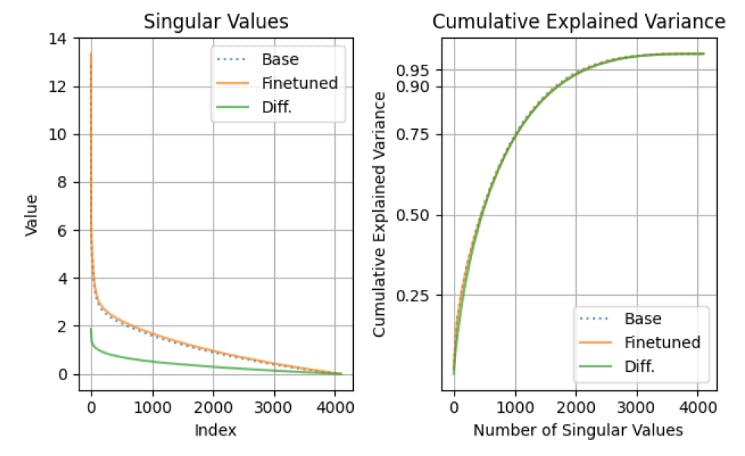Table of Links
3.2 Measuring Learning with Coding and Math Benchmarks (target domain evaluation)
3.3 Forgetting Metrics (source domain evaluation)
4 Results
4.1 LoRA underperforms full finetuning in programming and math tasks
4.2 LoRA forgets less than full finetuning
4.3 The Learning-Forgetting Tradeoff
4.4 LoRA’s regularization properties
4.5 Full finetuning on code and math does not learn low-rank perturbations
4.6 Practical takeaways for optimally configuring LoRA
Appendix
D. Theoretical Memory Efficiency Gains with LoRA for Single and Multi-GPU Settings
C Training Datasets
C.1 MetaMathQA (Math IFT)
The MetaMathQA dataset (Yu et al. (2023), https://huggingface.co/datasets/meta-math/MetaMathQA) contains 395,000 samples that are bootsrapped from the GSM (Cobbe et al., 2021) and Math (Hendrycks et al., 2021) training sets. These samples are augmented by GPT-3.5 using the following methods:
• Answer Augmentation (155k samples, Yu et al. (2023)): this method proposed by the MetaMathQA authors generates multiple reasoning paths for a given mathetical question and filters for generated reasoning paths that contain the correct final answer.
• Rephrasing (130k samples, (Yu et al., 2023)): this method proposed by the MetaMathQA authors uses GPT-3.5 to rephrase questions. They check for the correctness of rephrased questions by using few-shot Chain of Thought prompting to compare reasoning chains and proposed answers with ground truth answers.
Both Self-Verification (Weng et al., 2022) and FOBAR (Jiang et al., 2024) fall under the category of “backward reasoning,” where the question starts with a given condition and requires reasoning backwards to solve for an unknown variable. In order to generate new mathematical questions, a numerical value in the original question is masked as a variable X, and the question is rephrased accordingly.
MetaMathQA samples are organized by 4 columns: type, original_question, query and response.
We include two full examples below:
C.2 Magicoder-Evol-Instruct-110k (Code IFT)
C.3 Starcoder Python (Code CPT)
C.4 OpenWebMath (Math CPT)
Authors:
(1) Dan Biderman, Columbia University and Databricks Mosaic AI ([email protected]);
(2) Jose Gonzalez Ortiz, Databricks Mosaic AI ([email protected]);
(3) Jacob Portes, Databricks Mosaic AI ([email protected]);
(4) Mansheej Paul, Databricks Mosaic AI ([email protected]);
(5) Philip Greengard, Columbia University ([email protected]);
(6) Connor Jennings, Databricks Mosaic AI ([email protected]);
(7) Daniel King, Databricks Mosaic AI ([email protected]);
(8) Sam Havens, Databricks Mosaic AI ([email protected]);
(9) Vitaliy Chiley, Databricks Mosaic AI ([email protected]);
(10) Jonathan Frankle, Databricks Mosaic AI ([email protected]);
(11) Cody Blakeney, Databricks Mosaic AI (cody.blakeney);
(12) John P. Cunningham, Columbia University ([email protected]).
This paper is


